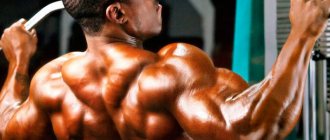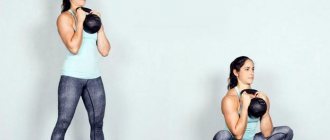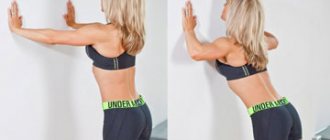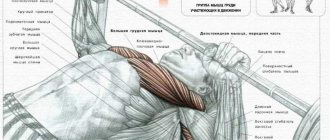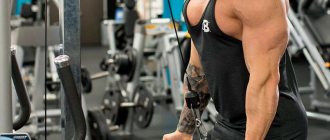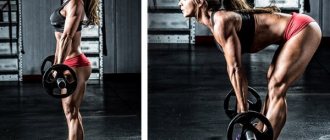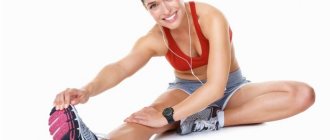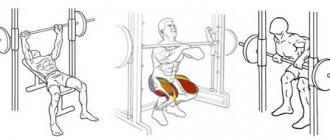Author: Timko Ilya - the ruler of the entire site and fitness trainer | more details >> Rod. 1984 Trained since 1999 Trained since 2007. Author and creator of the site tvoytrener.com. CCM in powerlifting. Champion of Russia and South Russia according to AWPC. Champion of the Krasnodar region according to IPF. 1st category in weightlifting. 2-time winner of the Krasnodar Territory championship in t/a. Author of more than 700 articles on fitness and amateur athletics. Author and co-author of 5 books.
Place in the author rating:
out of competition
(become an author) Date: 2015-09-19 Views: 141,577 Rating: 5.0
| All articles by the author >> | Medals articles >> |
Articles are loading...
| Article medals: | more than 100 thousand views |
Why medals are given to articles:
| Bronze medal: | |
| 1. The article is in the TOP 100 2. The article has more than 3. The article has more than 100 | |
| Silver medal: | |
| 1. The article is in the TOP 50 2. The article has more than 3. The article has more than 500 | |
| Gold medal: | |
| 1. The article is in the TOP 10 2. The article has more than 1 3. The article has more than 1,000 | |
Primary muscles : gluteus maximus and quadriceps femoris Additional muscles: hamstrings and inner thighs Difficulty : easy
Why do you need a machine for squats?
When a novice athlete begins training, his muscles are not sufficiently prepared for classic squats, even with an empty bar: the knees tremble and shake, the pelvis tilts forward/backward, and the bar slides onto the back. In such cases, a Smith machine is needed, allowing beginners to perform exercises for targeted muscle development.
When doing squats, a novice athlete will never fall, because he relies on the bar, which runs strictly vertically.
More experienced athletes use the simulator when they need to work alone, without a partner.
Plie on the Smith machine[edit | edit code]
Inventory
: Smith simulator.
Core muscles
: adductors (muscles of the inner thigh).
Additional muscles
: buttocks.
Level of training
: from beginner to advanced.
Different leg widths on the Smith machine provide different effects on the thigh muscles. This exercise, like everything on the Smith machine, eliminates unwanted stress on the spine. Such exercises are indispensable both at the initial stage of training and during recovery from injuries.
Step 1
. Place your feet wider than your shoulders, with your toes turned slightly outward. Place the bar on your shoulders.
Step 2
. Keeping your abs tight and your back straight, squat down until your thighs are parallel to the floor.
Step 3
. Return to the starting position.
Proper warm-up
Classes always begin with a warm-up without weights. Set the bar at such a level that the student does not rise on his toes, but also does not sag under the bar.
Stand under the bar so that it is between the neck and shoulder blades. Take a barbell and, lifting your elbows up, squeeze your shoulder blades together as much as possible. The weight is held on the muscles between them.
When performing direct squats, make sure (or ask someone to make sure) that your knees do not go further than your toes. The pelvis moves back as much as possible, the body moves slightly forward. The simulator will not let you fall.
Sit down to parallel with the floor or slightly lower, pause for half a second and stand up while exhaling. Repeat the exercise 9 times.
Description of the exercise
It is with the legs in front, otherwise these squats will be no different from classic squats with a barbell. The good thing about the Smith machine is that you can move your legs forward, because you simply can’t do this with a barbell - you’ll fall back.
Here the main load goes to the buttocks. Moreover, the more you move your legs forward, the more your buttocks are loaded. Just don't overdo it. It is enough to set it forward 15 - 20 cm. Well, don’t forget to squat deeply. Since this option is quite easy to implement, it is also suitable for beginners.
Main features
1. It is advisable to squat quite low. So that the pelvis falls just below the knee. That is, below the parallel of the thigh. Otherwise, you will pump more of your legs and not your buttocks.
2. Don't put your feet too far forward. The maximum is about half a step.
3. Please note that there are Smith machines in which the guides are already inclined. You need to take this into account and move your legs forward more or less, depending on which way you are facing.
4. Don't use a weight that you can't squat for at least 8 reps.
What to do, if:
- Taz is walking. You need to learn to squat without any weight at all until your pelvis moves.
- The bar cannot be removed from the clamps. You need to stand on the other side of it.
- My knees hurt. While doing the exercises, you need to make sure that your knees are parallel to each other and “look” in the same direction as your feet.
In general, such squats are only needed for beginners. Experts do not recommend using the exercise machine for more than a month. Next you need to switch to a regular barbell.
Execution technique
Initial position:
- Adjust the height of the bar in the rack to suit your height, taking into account that the squat is performed from the knees.
- Take the starting position in the Smith machine: lower yourself onto the mat, placing your knees slightly forward behind the projection of the bar, placing your thighs parallel to each other at the width of your pelvis or slightly wider. Extend your feet so that your shins are on the floor, or place your feet on your toes.
- Straighten your back, squeeze your shoulder blades together and place the bar on your trapezius. Statically tighten your core muscles.
Movement:
- As you inhale, slowly move your pelvis back, stretching your gluteal muscles, and at the same time slightly tilting your body forward.
- Lower yourself to the lowest point, touching your thighs to your shins, and without pausing while inhaling, due to the contraction of the gluteal muscles, lift to the starting position.
- Additionally, statically tighten your gluteal muscles at the top point.
- Complete the number of repetitions prescribed by the program.
Attention! Recommendations!
Dumbbell row: types and application features
A dumbbell row means a set of the same type of cast dumbbells of different weights. A solid dumbbell is a metal rod with a narrowed middle and rounded tips. All shells included in the set are mounted on a special holder, chassis or stand from which they can be conveniently removed.
The number of dumbbell pairs varies from five to infinity.
The dumbbell row is characterized by the following indicators:
- weight of the lightest pair;
- weight of the heaviest pair;
- step – the difference in kg between adjacent pairs.
For example, if they say: dumbbell row 11-81-2.5, this means that the weight of the lightest dumbbells in the row is 11 kg, the heaviest is 81 kg, and the difference between adjacent pairs is 2.5 kg. That is, in this dumbbell row the weight increases in the following order: 11 kg, 13.5 kg, 16 kg, 18.5 kg and so on - a total of 28 pairs of dumbbells.
It is believed that the smaller the step indicator, the more versatile the entire set: any athlete will be able to choose the most suitable pair of dumbbells for him according to his level of preparedness and training goal.
One of the most popular is the 50 kg dumbbell set. But besides weight indicators, dumbbells also differ in other characteristics, in particular:
- size of disks and handles;
- the shape of the disks (they are round and hexagonal);
- the material from which the projectiles are made;
- type of disk coating;
- disassembly / non-disassembly of dumbbells;
- relief of the handles and its type.
Therefore, in the name of these projectiles there may be such additional designations as rubber-coated dumbbells, hexagonal, collapsible, chrome-plated, hexagonal and others.
The equipment also differs according to the age and other characteristics of those involved. They can be children's, women's (for fitness), dumbbells for bodybuilders, etc.
Smith machine squats
Most often it is girls who perform them. After all, this is the most effective for working out the gluteal muscles. There are several options for implementation:
- With narrow and wide stance.
- On one leg.
- For maximum stretching of the buttocks.
During a regular Smith squat, the hips and buttocks work equally. However, the lumbar muscles practically do not work. The movement is carried out in a straight path, and this removes the load from the lower back. In fact, this exercise can be called isolating, because it does not give a powerful effect for the whole body, and does not contribute to severe fatigue. By doing this exercise, you simply work your thighs and buttocks.
The one-leg squat is very effective for the gluteal muscles. To perform it, you need to place your inactive leg on the bench so that you have support. This exercise gives the same effect as lunges, but the gluteal muscles at the lowest point receive additional static load.
There is also the option of squats for maximum stretching of the gluteal muscles. Girls should never neglect this exercise. In order for the effectiveness of the training to be maximum, the muscles must stretch well at the lowest point. This is achieved when performing such squats. Technique:
- Place the bar of the machine on your shoulders.
- Take half a step forward.
- Legs are shoulder-width apart and feet slightly turned out.
- Gently squat down until your thighs are parallel to the floor.
- Hold at the bottom for 3 seconds.
- Stand up.
At the bottom, the angle between your hips and shins should be 90 degrees. This can only be done with the help of a Smith machine. This is why we took half a step forward. The position of the body at the lower and upper points is as follows:
When performing all variations of squats in the simulator, the following rules must be observed:
- Keep your lower back arched.
- Keep your knees straight.
- Don't lift your heels off the floor.
- Perform this exercise in three sets of 12-15 repetitions.
- You need to work in the Smith machine with medium weights.
- Do this exercise at the end of your leg workout.
Smith exercise machine
And then the moment came when you found out that in the gym there are not only barbells and dumbbells, but there are also functional exercise machines with which you can pump up your body and also effectively come to training and load your muscles without dumbbells and barbells, which may already be tired and want to diversify your fitness bodybuilding workouts with other physical movements!
This article is dedicated to the Smith machine. Today we will tell you what exercises you can do for your legs, hips, buttocks, arms, biceps, triceps, shoulders, and back. If we talk about efficiency, what is the best equipment to train with in order to get better results from training, then we can say the following: it is best to combine training with dumbbells, barbells, including in your training program exercises that can be done in the Smith machine and Crossover.
First, let's talk about the exercises that can be done in the Smith machine and what it is. The Smith machine is a power frame with a fixed barbell, which has a number of advantages and disadvantages!
Pros and cons of the Smith machine for girls and women
- No insurance is required since the exercise machine has clamps on the barbell and there are hooks in the power frame at any height so that at any time during the exercise, if you find it difficult to do, you can quickly hang the barbell. Safety is the strong point of the simulator; you don’t need to call your partner’s trainer to back you up; you can do everything; the main thing is to hang the barbell on time when you feel like you’re running out of strength!
- The second advantage is that with many exercises on the legs, for example, performing lunges, squats on the leg muscles, you remove a lot of load from the spine, if you squat with a barbell, then you need to maintain balance and balance, then here everything is simple: you took the position, positioned barbell on the trapeze - shoulders, and started doing it, the only thing you need to watch is the technique of the legs, so that there is a correct trajectory of the legs.
- Friction plus that you can do one of the most difficult exercises for the buttocks is lunges with a barbell on your shoulders, since it is very convenient that the barbell is held in one position, if you perform this exercise with free weight, then the barbell is very difficult to control, and it moves right and left Much attention is paid to balance and balance, but here everything is simply positioned with one leg back and the other forward, the back is straight, the gaze is directed forward, and you can start performing! This exercise is popular among fitness beginners, girls and women who strive for larger buttocks and want to pump up the most beautiful legs. Many girls and women also do not perform lunges with dumbbells, but replace and do lunges in Smith!
- The fourth plus is that many exercises can be easily performed according to the technique and you don’t need to set up and practice for a long time, here you can say it will work out right away, the main thing is not to put a lot of weight on the bar at once, but gradually increase the load on muscle strength.
- The machine still has some drawbacks, and if we talk about many exercises, from the point of view of movement trajectories, they do not include many muscles, stabilizers, which are trained if you train with free weights, so whoever starts training with iron over time cannot do everything at once, since Smith removes many psychological fears, as insurance is not needed, but with free weights, for example, when bench pressing, squats, it is always necessary, and also the load that you did in Smith will be different from weights with a barbell and you need to use less since the barbell will include stabilizer muscles on full force, based on the fact that they did not receive a load in the Smith machine.
All exercises in the Smith machine
on the chest
- Bench press on a horizontal bench
- Incline Bench Press
- Angled push-ups
on the back
- Bent-over barbell row with classic grip
- Reverse grip barbell row
- One arm row
on shoulders
- Seated Front Press
- Seated overhead press
- Barbell row to the chin
biceps forearm
- Classic grip biceps curl
- Reverse grip curl
for triceps
- Seated French press
- Close grip press
on the buttocks legs back
- Sumo squats
- Classic squats
- Lunges in place
- Deadlift on straight legs
